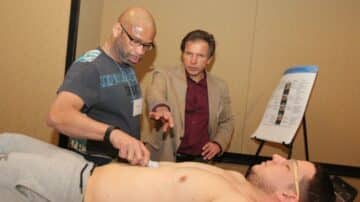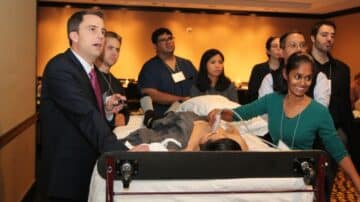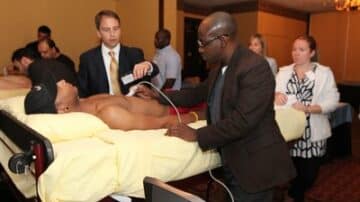Ultrasound technology has revolutionized the medical industry and provided physicians with the ability to visualize internal tissue and organs in real time. Advancements and changing trends in medical technology have also seen smaller and more affordable ultrasound machines cropping up…
Read MoreMore Articles – Chest Tube, Emergency Procedures, FAST Exam, Featured, King Tube, Medical General, RUSH Exam
Injury causes over 150,000 deaths per year in the U.S. and over 5 million worldwide. Around 80% of these traumatic injuries are blunt, with incidences of fatality secondary to hypovolemic shock and intraperitoneal bleeds. Fatalities can be prevented if professionals…
Read MoreDelays to hospital inpatient admission in excess of five hours from arrival at an Emergency Department (ED) lead to a mortality rate of 8.71%. This increases by another 8% in cases where admission is delayed beyond six to eight hours. …
Read MoreMore Articles – Arterial line, Cardiovascular diseases, Central line, Chest Tube, Emergency Procedures, Endotracheal Intubation, Events, FAST Exam, Intraosseous line, King Tube, Laryngeal Mask Airway, Lumbar Puncture, Mechanical Ventilation, Medical General, medical procedures, Needle Decompression, Paracentesis, Procedural Sedation, RUSH Exam, Thoracentesis, Ultrasound-Guided Peripheral IV
Physicians, physician associates (PAs), and nurse practitioners (NPs) need to be adept in a range of essential medical emergency procedures that they must perform in an inpatient settings. These bedside procedures are accomplished readily, but only if you have the…
Read MoreA Continuing Medical Education (CME) Course is designed for doctors, nurses, nurse practitioners, physician associates and other healthcare professionals who want to learn more about certain topics in medicine. The primary goal of CME is to improve the quality of…
Read MoreThe emergency room (ER) is an essential area of any hospital because it often deals with life-and-death situations. How medical personnel respond significantly affects the prognosis of patients who are in need of urgent care. As a medical professional, experience…
Read MoreAs an aspiring doctor, nurse, nurse practitioner or physician associate you probably already know how important it is to have a license to practice. Not only does it allow you to work in your field, but it also shows that…
Read MoreFor decades the mantra for procedural education in medicine has been “see one-do one-teach one”. Those of us who learned bedside procedures and point-of-care ultrasound by this model understand that this approach does not optimize safe and competent performance. At…
Read MoreAs a third year medical student at a busy trauma center, one of my jobs was to hold a bag of saline connected to the trauma victim’s abdomen and throw the bag to the ground when it emptied. While I…
Read MoreUnited Kingdom’s National Institute for Health and Care Excellence (NICE) recommends the following as guidelines for imaging and transfusion in trauma: Key Recommendations Use CT early and liberally in adults with major trauma, even omitting plain films and the focused…
Read MoreMore Articles – Arterial line, Central line, Chest Tube, Emergency Procedures, Endotracheal Intubation, FAST Exam, Glidescope Intubation, Hospital Procedures, King Tube, Lumbar Puncture, Medical General, medical procedures, Needle Decompression, Paracentesis, RUSH Exam, Thoracentesis, Ultrasound-Guided Peripheral IV
Hospitalists are in the ideal position to perform bedside procedures on their patients. They know every aspect about their patients and have had the opportunity to develop a good rapport and the trust of their patients. So, why are they…
Read MoreMore Articles – Chest Tube, Emergency Procedures, FAST Exam, Medical General, medical procedures, Respiratory diseases
Pneumothoraces are a common problem in the ER and the ICU. The traditional screening test for a pneumothorax in the hospital is the chest radiograph; however, chest radiographs are not very sensitive in the setting of trauma and in ventilated…
Read MoreCategories
- ACLS (1)
- Arterial line (33)
- Cardiovascular diseases (77)
- Central line (55)
- Chest Tube (39)
- Dermatology (4)
- Emergency Procedures (138)
- Endocrinology (6)
- Endotracheal Intubation (36)
- Events (24)
- FAST Exam (12)
- Featured (112)
- Featured Procedure (42)
- Gastrointestinal diseases (32)
- Ginecology (3)
- Glidescope Intubation (21)
- Hematology (33)
- Hospital Procedures (85)
- Infections (32)
- Intraosseous line (8)
- King Tube (27)
- Laryngeal Mask Airway (18)
- Lumbar Puncture (36)
- Mechanical Ventilation (34)
- Medical General (95)
- medical procedures (258)
- Needle Decompression (6)
- Nephrology (11)
- Neurological diseases (12)
- Oncology (4)
- Paracentesis (32)
- Pericardiocentesis (3)
- Procedural Sedation (19)
- Respiratory diseases (85)
- RUSH Exam (8)
- Thoracentesis (37)
- Traumatology (24)
- Travel (27)
- Ultrasound-Guided Peripheral IV (13)











